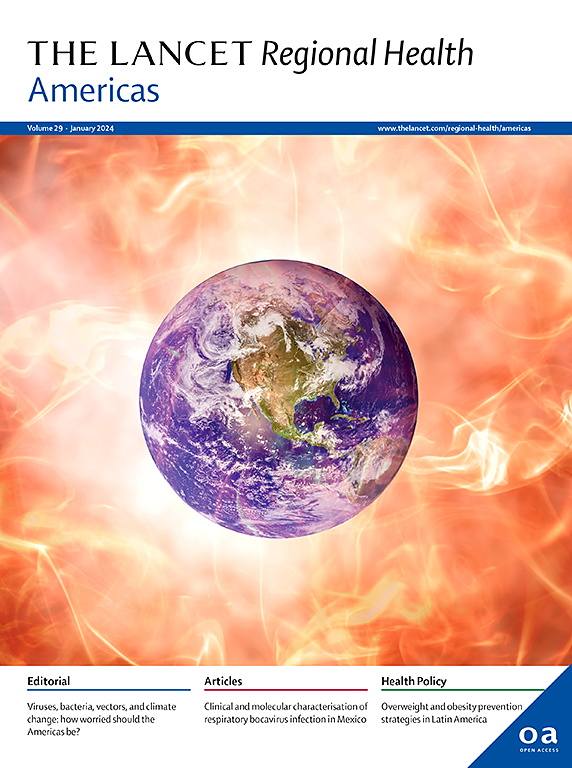The epidemiology of bacterial meningitis in the United States during 2008–2023: an analysis of active, laboratory, population-based, multistate surveillance data
IF 7
Q1 HEALTH CARE SCIENCES & SERVICES
引用次数: 0
Abstract
Background
Bacterial meningitis is a severe syndrome with dynamic epidemiology, but assessments of current trends are limited. We aimed to describe changing epidemiologic patterns among common bacterial causes of meningitis in the United States.
Methods
We analyzed data on bacterial meningitis cases caused by Streptococcus pneumoniae, group B Streptococcus (GBS), Haemophilus influenzae, Neisseria meningitidis, and Listeria monocytogenes in 10 U.S. surveillance sites. We compared incidence (cases per 100,000) across four epidemiologic periods: 2008–2009, 2010–2019, 2020–2021, and 2022–2023.
Findings
We identified 5,032 bacterial meningitis cases; among those with outcome data, 11% (573/5028) died. S. pneumoniae was the dominant pathogen (59% [2922/5032]) throughout. However, GBS predominated among infants aged 0–2 months (85% [660/775]), the age group with the highest incidence. Between 2008–2009 and 2010–2019, overall bacterial meningitis incidence declined from 1.3 to 1.1, driven by decreases in S. pneumoniae meningitis caused by serotypes contained in the 13-valent pneumococcal conjugate vaccine (PCV13) and N. meningitidis meningitis. Meningitis caused by non-b H. influenzae strains increased during this period. During 2020–2021, incidence declined to 0.7, driven by decreases in S. pneumoniae, H. influenzae, and N. meningitidis meningitis, regardless of organism subtype. During 2022–2023, incidence increased to 1.0, driven by increases in S. pneumoniae and H. influenzae meningitis. Case fatality ratios remained stable throughout.
Interpretation
Bacterial meningitis incidence rates have declined since 2008, with a notable low during 2020–2021, followed by a resurgence during 2022–2023. Case fatality remains high. Strategies that provide effective and broader pneumococcal and H. influenzae serotype protection and prevent infant GBS meningitis could reduce residual meningitis burden.
Funding
U.S. Centers for Disease Control and Prevention.
2008-2023年美国细菌性脑膜炎的流行病学:对活跃的、实验室的、基于人群的、多州监测数据的分析
背景细菌性脑膜炎是一种具有动态流行病学的严重综合征,但对当前趋势的评估有限。我们的目的是描述在美国常见的细菌性脑膜炎病因中不断变化的流行病学模式。方法分析美国10个监测点由肺炎链球菌、B群链球菌(GBS)、流感嗜血杆菌、脑膜炎奈瑟菌和单核增生李斯特菌引起的细菌性脑膜炎病例资料。我们比较了2008-2009年、2010-2019年、2020-2021年和2022-2023年四个流行病学时期的发病率(每10万例病例)。我们发现5032例细菌性脑膜炎病例;在有结果数据的患者中,11%(573/5028)死亡。肺炎链球菌为优势致病菌(59%[2922/5032])。然而,GBS以0-2月龄婴儿为主(85%[660/775]),是发病率最高的年龄组。2008-2009年至2010-2019年期间,由于13价肺炎球菌结合疫苗(PCV13)和脑膜炎奈瑟菌脑膜炎所含血清型导致的肺炎链球菌脑膜炎发病率下降,细菌性脑膜炎总发病率从1.3下降至1.1。在此期间,由非流感嗜血杆菌菌株引起的脑膜炎有所增加。在2020-2021年期间,由于肺炎链球菌、流感嗜血杆菌和脑膜炎奈瑟菌(不论何种生物亚型)的减少,发病率降至0.7。在2022-2023年期间,由于肺炎链球菌和流感嗜血杆菌脑膜炎的增加,发病率增加到1.0。病死率始终保持稳定。细菌性脑膜炎发病率自2008年以来有所下降,在2020-2021年期间显著下降,随后在2022-2023年期间回升。病死率仍然很高。提供有效和更广泛的肺炎球菌和流感嗜血杆菌血清型保护和预防婴儿GBS脑膜炎的策略可以减少残余脑膜炎负担。疾病控制和预防中心。
本文章由计算机程序翻译,如有差异,请以英文原文为准。
求助全文
约1分钟内获得全文
求助全文
来源期刊

Lancet Regional Health-Americas
Multiple-
CiteScore
8.00
自引率
0.00%
发文量
0
期刊介绍:
The Lancet Regional Health – Americas, an open-access journal, contributes to The Lancet's global initiative by focusing on health-care quality and access in the Americas. It aims to advance clinical practice and health policy in the region, promoting better health outcomes. The journal publishes high-quality original research advocating change or shedding light on clinical practice and health policy. It welcomes submissions on various regional health topics, including infectious diseases, non-communicable diseases, child and adolescent health, maternal and reproductive health, emergency care, health policy, and health equity.
 求助内容:
求助内容: 应助结果提醒方式:
应助结果提醒方式:


